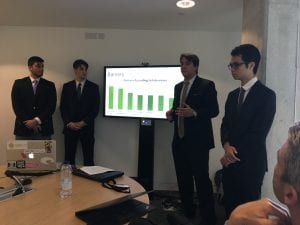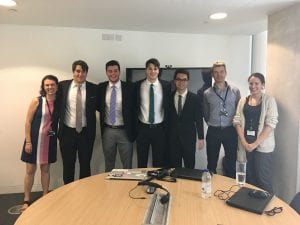Sustainable urban Drainage System (SuDS) in Camden
| Sponsor: | London Borough of Camden |
|
| Sponsor Liaisons: |
Ana Lopez, Sustainability Officer (Planning) Harold Garner, Energy and Sustainability Manager Acacia Hasler, Principal Transport Planner |
|
| Student Team: | Benjamin Abram, Chase Arsenault, Antonio Goncalves, Oscar Lee | |
| Abstract: | The London Borough of Camden has had two major flood events in 1975 and 2002 that caused disruption to business and transportation. The Council is concerned that such flood events will become more common in the future as climate change brings more intense storms with increasing frequency to U.K. The project goal was to determine a strategy to mainstream Sustainable urban Drainage Systems (SuDS) into the public realm work of the Highway and Transport Strategy Teams. We conducted desk-based research, interviews, and site visits to identify the actual and perceived benefits and barriers to the adoption of SuDS and potential strategies to promote their adoption in the borough’s public highways. | |
| Link: | ||
Executive Summary
In the London borough of Camden (LBC), there have been two major floods in 1975 and 2002, and in the coming years, climate change is projected to cause more frequent and severe storms. The LBC has created policies that encourage the implementation of sustainable developments, specifically sustainable urban drainage systems (SuDS). The primary purpose of this report was to outline a strategy to mainstream SuDS into Camden’s public realm’s highways and streetscapes projects. We developed the following five objectives to reach our goal:
- Identified the policies encourage the incorporation of SuDS into the public realm projects.
- Examined the extent to which the current engineering and transport strategy projects reduce the risk of flooding.
- Assessed the benefits of the adoption of SuDS.
- Evaluated the barriers preventing the adoption of SuDS and identified potential solutions to overcome them.
- Identified opportunities for incorporating SuDS in Camden’s public realm projects.
Through desk based research and discussions with the Camden council staff and advocates of SuDS from other boroughs, we found that flooding from rapid runoff due to impermeable surfaces poses a substantial risk for Camden. The combined drainage and sewer system is already overtaxed and is likely to be stressed further as the population grows and climate change leads to more frequent and intense storms. Many policies in place at the national, regional, and local level encourage SuDS. The many benefits of SuDS, besides reducing flood risk, include reduced stress on the storm water system, increased recharge of aquifers, and amenity values. Camden council has not yet implemented any SuDS schemes although some private SuDS projects have been implemented in the borough. Lack of knowledge about the range of benefits associated with SuDS technologies and concerns and misperceptions about costs of construction and maintenance have impeded the adoption of SuDS schemes in the borough. Other barriers to the implementation of SuDS in the borough include employee resistance to the adoption of new technologies that they fear are unproven, or may be irrelevant to the goals that they are trying to achieve. Staff were also concerned about the conflict caused by potential SuDS schemes displacing parking spots that are at a premium in the borough. Finally, staff were concerned about funding opportunities.
Conclusion and Recommendations
Camden is at risk of surface water flooding, an obstacle that can be overcome through the implementation of SuDS. SuDS offer many benefits beyond flood risk reduction but they have not been implemented in Camden due to a number of barriers. Many planned streetscape and highway projects offer opportunities for the incorporation of SuDS. The main barriers to the adoption are lack of awareness about the range of SuDS technologies available and a lack of knowledge about the true costs and benefits. Contrary to expectations, the costs of installing and maintaining SuDS are often less than the costs of conventional drainage schemes, and they offer many additional benefits over conventional schemes, such as reduced flood risk, increased amenity values, improved air and water quality, the promotion of biodiversity, and reduction in climate impacts. The team identified several proposed transport projects that Camden is considering and explored the possibility of integrating SuDS components in the highway schemes. Based on the findings from the interviews and background research the project team recommends that the Camden Council:
- Revise the “Camden Transport Strategy” to clearly emphasize the need to include SuDS in future streetscape and highway projects.
- Provide more information to staff regarding the costs and benefits of SuDS schemes through various means such as:
- Guidance documents and other resources;
- Site visits to schemes implemented in neighboring boroughs;
- Lectures and workshops by SuDS experts/organizations, such as John Bryden of Thames 21, TfL, George Warren of Hammersmith and Fullham, and Ian Russel of Enfield Council.
- Develop pilot schemes based on the projects identified and evaluate the success of the pilot schemes according to various stakeholders, including council staff, residents near the schemes and other users, such as cyclists.
- Collaborate with Georgie Street of Camden Town, who has expressed interest in working with the Council to implement SuDS in that district
Adopting SuDS in Camden is appears to be a feasible goal for the borough and options for integrating SuDS should be considered in the design phase of all future highway and streetscape projects.




